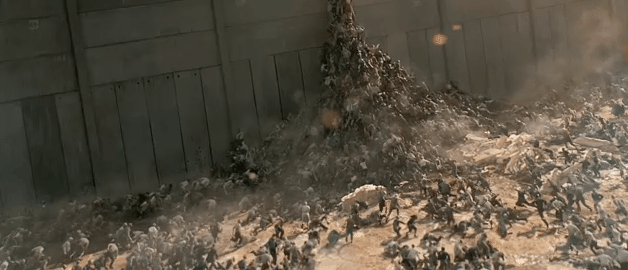As Jiu-Jitsu instructors, we want a school much like the Island scene in Enter the Dragon – students uniformly executing their technically-sound techniques in effortless synchrony. A far cry from the reality of teaching, where students often develop a hodgepodge of techniques in scattershot fashion. This is where coaching and teaching abilities come in.

It’s never like this… except maybe at Third Law with their lasso guard.
A student recently asked whether he should focus on improving strengths or weaknesses. My knee-jerk inclination was to respond weaknesses. But as I gathered my thoughts, I realized this was a more complex question.
Two Types of Weaknesses
The two types of weaknesses are VOIDS and BOTTLENECKS. A VOID is the lack of a system. The guy without a bottom game. The girl without takedowns.
The BOTTLENECK is a little more complicated.
Compare the following scenarios…
I’m on the bottom of mount and I can’t get out.
I’m on top of the mount but I can’t submit my opponent.
Both these scenarios have exposed “weaknesses” but are very different situations. The first is survival. The second is not. One is defense. The other is offense.
Concept of Vertical and Horizontal Progressions
Jiu-Jitsu is a chain of positional advancements, where each position builds upon the last. The analogy of a skyscraper fits here, with each floor built on top of the other. I call these type of progressions “verticals”. In the skyscraper analogy, the basement would the bottom of mount and the penthouse would be the top of the mount.
This is in contrast to “horizontal” progressions. A Horizontal is moving from one non-intrinsically-superior position to another non-intrinsically-superior position. For example, transferring from Spider Guard to Reverse De La Riva. In other words, De La Riva is not “better” than the Spider Guard… unless you’re a De La Riva player.
As the Jiu Jitsu student gets closer to Black Belt, it becomes more and more important to focus on Horizontal progressions and filling VOIDS. At that point, all your opponents have strong verticals and much of your success depends on your ability to escape opposing Verticals and to bring opponents into yours.
Build Your First Vertical Based on Offense
The natural learning style for most humans depends a lot on positive feedback. Most people need validation along the journey to continue with the activity.
As instructors, we often try to circumvent this natural learning process. Example: every Jiu-Jitsu coach gets the idea to focus on escapes and defense for beginners. Maybe even create an escape-heavy curriculum. I’ve done it before … but it never culminates in an elite force of White Belts that can escape the mount at will.
Imagine two scenarios…
1. Student learns a new offensive technique (tricky triangle from guard)
2. Students learns a new defensive technique (escape from side mount).
In the first scenario, the student will be able to tapout his opponents. Even if he doesn’t get a finish, he’ll be able to lock on something and think “oh I almost had him.” He feels close to victory and identifies the triangle as “his move”. He starts figuring out ways to get to the triangle and how to finish it.
In the second scenario, the student will most likely be demoralized even if he escapes the side mount every single time. Escaping a bad position doesn’t have the same weight as achieving a good one (or getting a tap).
Step one should be to develop an offensive system that works for you.

How a White Belt feels getting their first tap!
Not All Weaknesses Need to Be Fixed
The second reason to build off of strengths is that not all the weaknesses need to be addressed. For instance, Roger Gracie might have an underdeveloped Berimbolo game but does the 10x Black Belt World Champion really need one? Its a superficial weakness given his ability in other positions and his ability to enforce “his game” on his opponents.
In other words, not all VOIDS need to be addressed right away.
The Defensive Aspect of Force Concentration
The final reason why working on bottlenecks might not be a good idea is based on the the concept of force concentration.
Force concentration is the practice of concentrating a military force, so as to bring to bear such overwhelming force against a portion of an enemy force that the disparity between the two forces alone acts as a force multiplier, in favour of the concentrated forces.
Anytime a competitor has an area of immense strength, he can prevent his opponent from making any horizontal transitions out of the position and gets the added advantage of predicting what his opponent’s strategy will be. His adversary has to (A) act stupidly to avoid the area of strength i.e. pulling guard to the wrong side to avoid takedowns or (B) fight the strength head-on in a mentally and physically grinding battle. Examples of (B) would be like DJ Jackson’s stifling top game and the Miyao’s Berimbolo. While each fighter is not guaranteed a pass or the sweep vs. the elite of their division, they can smother and keep opponents within their game.
Due to this ability to focus, the Vertically Strong fighter often gets to “hide” his bottlenecks and even his voids.
Bottom line: Being *VERY* good at a few things will get you better results than ‘not sucking’ at everything.

World War Z zombies understood the importance of Force Concentration and Developing Offensive Verticals.
In Conclusion
Weaknesses need to be separated into bottlenecks and voids. For beginners, you should focus first on developing one system that you do very well; this will usually be a guard attack or guard passing series. Learn how to progress to better positions from your system and also how to get into your system from bad positions (develop vertical). Then learn how to get into your system from neutral positions (develop horizontal).
I actually had the original questioner proofread this article and he asked for specific recommendations.
Background: He is a very physically strong Blue Belt. He excels in a variety of armlock submissions from on top and in training has submitted grapplers of every belt color with these techniques. His guard remains a threat due to the danger of armlocks but does not utilize the right combination of sweeps & submissions and is largely reactionary. His escapes are strength-dependent and explosive.
So should he drop everything and start working on guard or side-mount escapes? My plan would be this…
- Build upon his existing armlock ability by focusing on a strong underhook & smashing half-guard passing system. This will add a strong positional advancement component to his existing submissions. When the opponent turns, he will go into the Kimura trap rather than the classic bow & arrow.
- Be comfortable on the bottom of the Under-Over position as failure to finish his preferred Kimura or the Armbar attacks puts him there. A good example of the type of bottom game he needs was a European Purple Belt named Janne Autio. He utilized it very well vs. Joao Gabriel Rocha in the early rounds of the 2010 Worlds.
- Develop a functional half guard especially from bad positions.
- Fix Side Mount Escapes (will be 80% fixed by this point due to #3). His tendency to bridge or roll his opponent over rather than going for guard or grabbing the legs is because he doesn’t have a guard he is comfortable in. So it makes sense to try to roll or bridge his opponent right over and be on top. Once he has faith in his smashed half-guard and an offensive guard, he’ll be more receptive to turning into his opponent for guard or shots.